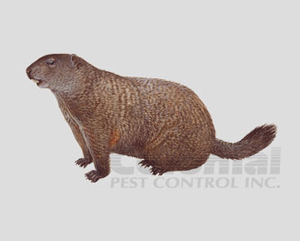How Many Tomatoes Can a Woodchuck Chuck?
By Chris Williams on June 20, 2013.

Question
What does a woodchuck’s burrow look like? We’ve caught a couple of glimpses of a large brownish animal in our vegetable garden but we haven’t been able to see where it’s coming from. It doesn’t look like a raccoon, so I think it must be a woodchuck.
Answer
The fact that you’ve spotted it in your vegetable garden would seem to reinforce the thinking that it’s a woodchuck. While a raccoon might feed on fresh vegetables, too, woodchucks really, really love vegetables and can decimate a garden in no time. A single adult can weigh up to 12 pounds and can eat 1-2 pounds of vegetation each day. Woodchucks can cause a lot of damage around a home with their feeding, gnawing, and burrowing.
Woodchucks (also called groundhogs) are vegetarians, feeding on grasses, weeds, clover, and also on ornamental plants and garden crops like cabbage, lettuce, beans, carrots…and tomatoes. If you have fruit trees, your fruit is not safe either. Woodchucks will climb fruit trees to get at the cherries, apples, pears, and other fruit. As if that wasn’t enough, woodchucks are also gnawers and can damage trees, shrubs, decks, siding, and outdoor furniture as they sharpen their incisors.
Where Do Woodchucks Live?
Back to your original question about their burrows. Woodchuck burrows are usually in the ground, but often in the ground under sheds, decks, stonewalls, or other large structures, or even in crawlspaces. Their large burrows can undermine foundations. Also look under shrubs, brush piles, or woodpiles for burrow openings. A woodchuck burrow is a big, deep hole with an opening that is about 8-12 inches across. Woodchuck burrow openings are distinguished by a large, loose mound of dirt pushed out of the opening and called a “porch.” It’s also said that you will often find flies and a distinctive odor around the opening to an active woodchuck burrow. There may be a second opening into the burrow as well. Underground, the burrow consists of large tunnels and sleeping chambers that have been known to cave in when riding lawn mowers drive over them.
Woodchucks are active in the daytime and tend to be seen lumbering along or basking in the sun, unless they are chowing down on your produce instead. They only travel about 50 to 150 feet from their burrow if food is nearby. If you look closely, you might find that your woodchuck has even worn a trail from your garden back to its burrow. The good news is that woodchucks are solitary animals so you are probably dealing with just one in your yard.
To get rid of a woodchuck, you need a wildlife specialist licensed and certified in humane removal of nuisance wildlife. Fortunately you don’t have to look far–at Colonial, we’ve been helping our customers with woodchuck and other pest animal problems for more than 25 years. Give us a call.